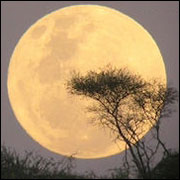
It may have been a “bad moon” rising in the famous 1969 song by Creedence Clearwater Revival, but this weekend’s full moon could well inspire predictions for trouble of a similar kind.
That’s because it’s this year’s “supermoon” — the full moon that occurs when the moon is closest to Earth — and supermoons are often believed to wreak even more havoc on our planet than ordinary full moons do.
Along with the higher tides that are known to follow, dire warnings about supermoons can range from natural disasters such as earthquakes and volcanic eruptions to the inadvisability of practicing yoga.
Is there’s any truth behind the concerns? That’s another story.
‘It Is Brighter’
“At ‘supermoon,’ the full moon is at its closest approach to Earth in its orbit,” Mario Livio, a senior astrophysicist with the Space Telescope Science Institute, told TechNewsWorld. “Consequently, it is brighter than a regular full moon.”
Not only is that fun to watch, but tides can be stronger as well, he noted.
“However, as far as I am aware, all claims that a ‘supermoon’ results in an enhanced risk for earthquakes have been shown to be dubious,” Livio added. “Claims for other types of disasters can be dismissed altogether.”
A ‘Perigee-Syzygy’
Astrologer Richard Nolle claims credit for having coined the term “supermoon,” which he defines as a full moon that occurs when the moon is at or within 90 percent of its closest approach to Earth in a given orbit.
“In short, Earth, moon and sun are all in a line, with moon in its nearest approach to Earth,” Nolle explains.
It’s known as “perigee” when the moon is at that closest spot to Earth on its elliptical orbit; accordingly, a supermoon of this kind is also known tongue-twistingly as a “perigee-syzygy.”
“The moon’s distance from the Earth changes over the course of a month since the orbit of the moon is slightly elliptical,” Scott Austin, associate professor of astronomy and director of the astronomical facilities at the University of Central Arkansas, told TechNewsWorld. “Perigee and full moon happen every month, but only rarely do they occur at the same time.”
The opposite of perigee is apogee, which occurs when the moon is at its greatest distance from Earth.
There’s even an online calculator that can be used to figure out when a supermoon will occur in any given year.
’30 Percent Brighter’
Last year’s supermoon occurred on March 19, when the moon was roughly 356,577 km from Earth, causing widespread speculation — now largely discounted — that it played a role in the 2011 Tohoku earthquake in Japan.
This year’s supermoon will take place on May 6 at 03:35 UT, or 10:35 p.m. Central Daylight Time on Saturday in North America, according to NASA. At that point, the moon will be some 356,953 km away from Earth — its closest point for the year, but not as close as last year’s supermoon was.
“This full moon will appear about 14 percent larger and 30 percent brighter than the average full moon,” Austin said.
That may sound striking, but “the casual moon observer probably won’t notice these differences,” he added.
‘You Would Need a Good Instrument’
Of course, it’s not that the moon actually gets bigger, Paul Czysz, professor emeritus of aerospace engineering at St. Louis University, told TechNewsWorld.
It may appear that way due to proximity, but even then the difference is too small to discern with the naked eye, Czysz said.
“You would need a good optical instrument to measure the difference,” he asserted.
‘People Will Notice’
Those who likely will notice a change, however, are those living in coastal areas, Austin pointed out.
“The primary physical significance of having the moon’s monthly perigee occurring at the same time as the full-moon phase is that the ocean tides will be nearly as extreme as possible,” he explained.
“The highest and lowest tides occur when the sun, Earth and moon are aligned,” as in a full moon or new moon, Austin noted. “The gravitational pull of the sun and moon act together during those phases, causing the highest high tides and the lowest low tides.”
Since the moon will be at its closest approach during this upcoming full moon, the tides will be more extreme than average, he predicted: “People living in coastal areas will notice the difference.”
Looking Ahead to 2016
Next year’s supermoon will take place on June 23, 2013, when the moon will be about 356,989 km away from Earth. Perhaps even more notable, though, is the one that will take place on Nov. 14, 2016, when that distance will fall to just 356,511 km — even closer than the one last year.
Should we start planning now for the possibility of fresh disasters? Probably not.
“There’s a lot of myths that go back thousands of years as to how the Earth is influenced by all these things around us,” Czysz noted, adding that in this case they’re just that: myths.
Then again, as Livio added, “the psychological effects on humans are hard to predict.”






















































Creedence Clearwater Revival excellent band but truly underrated in my opinion. Bad Moon Rising pretty upbeat song with good lyrics.